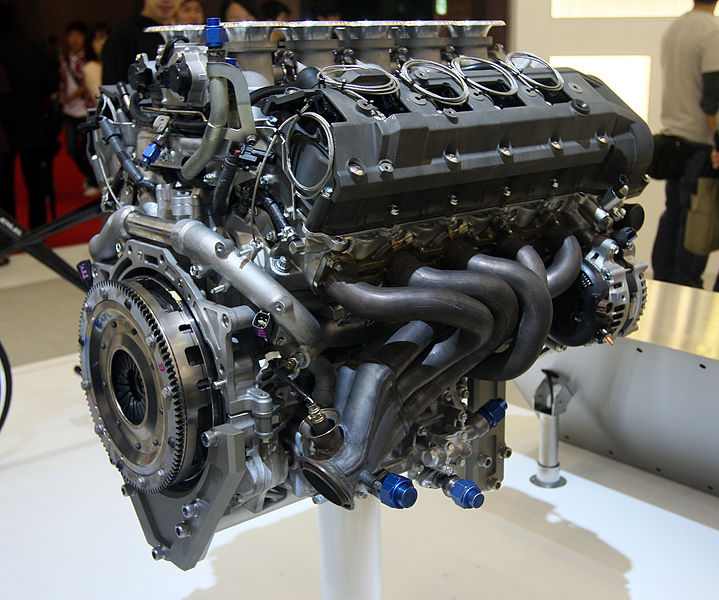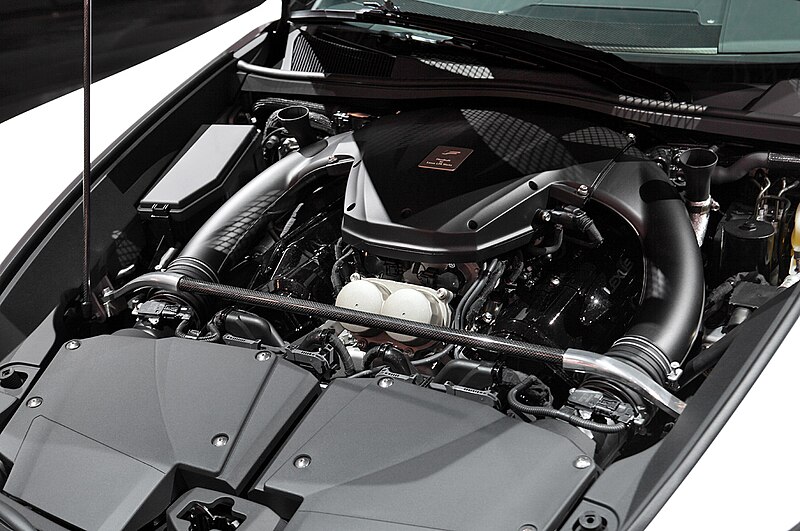
Three concept versions have been shown, each debuting at the North American International Auto Show with the LF-A designation as part of the LF Series concept line. The first LF-A concept premiered in 2005, followed in 2007 by a second LF-A with a more completely furnished interior and exterior.
The third version of the LF-A, a roadster model, premiered in 2008. The production model, trademarked LFA, was shown at the Tokyo Motor Show in October 2009.
The production Lexus LFA features a new V10 engine and a carbon fiber-reinforced polymer (CFRP) body. CFRP materials account for 65 percent of the LFA's body composition by mass.
The LFA went into production in late 2010, with a projected run of 500 vehicles at the base price of US$375,000. A circuit-tuned variant is scheduled for 2012.
Production
Lexus began taking orders for the LFA supercar on October 23, 2009. Buyers will be selectively chosen by Lexus in the second quarter of 2010. Production will begin in December 2010 as a 2011 model. Only 500 total LFA models will be made worldwide, with only 20 produced each month. Each car will be custom ordered to the customer's specifications, and will cost an estimated US$375,000, depending on options and customization.

In total, there are over 30 billion possible configurations. Each LFA will be hand-built by a dedicated production team of engineers and specialists at Toyota's Motomatchi plant in Aichi, Japan.
In the North American market 150 LFAs will be initially sold through a two year lease program much like the Ferrari F50. This is to prevent owners from reselling the vehicle for a profit.
Racing driver Scott Pruett was hired to give test drives to interested buyers, demonstrating the vehicle's capabilities at Auto Club Speedway. The Lexus division of Toyota Motor USA will stop taking orders at the end of 2009, in which they will talk about a purchase plan for the lessees.
Lexus later changed their stance and allowed outright purchase, but only on the condition that they sign an agreement giving the dealer first right of refusal to buy back the LFA if the owner wants to sell it within the first two years. The dealer will have the option to buy back the used LFA for either fair market value or the original sticker price, whichever is lower. [47] In the European market buyers order their LFA through a single Lexus dealer located in Park Lane, London where it is purchased outright.
During LFA production, each vehicle will receive a plaque which is individually numbered, indicating the unit's place in the production run. Each LFA V10 engine will also bear the signature of the specialist who assembled it. With 20 units produced monthly, production of the entire LFA run will last for 25 months, from December 2010 to December 2012.
Engine
The Lexus LFA is powered by a 72-degree bank angle 4.8-liter V10 engine equipped with dual VVT-i carrying the 1LR-GUE designation with a maximum output of 412 kW (560 PS) delivered at 8,700 rpm.
Its maximum torque output of 480 N·m (354 lb·ft) arrives at 6,800 rpm, 90 percent of which is available from 3,700 rpm. The engine redlines at 9,000 rpm, but with a fuel cutoff set at 9,500 rpm, and is constructed using forged aluminum pistons, forged titanium connecting rods, and solid titanium valves.
The V angle of the LFA's V-10 engine is set to 72-degrees (as opposed to the 90-degree V angle present in a Dodge Viper's V-10) to fully balance the firing force from the pistons.
This 72-degree angle allows for even firing from the pistons without the use of a split-journal crankshaft, thus improving engine efficiency as well as lowering overall weight.
Dry sump lubrication prevents engine oil starvation through high speed corners and lowers the engine's center of mass. Air is fed directly from beneath the hood through a visible slit passing into a dual stage variable intake manifold and then into ten individual throttle bodies before finally exiting from a dual stage titanium muffler.
The LFA's engineers selected a V10 engine over an equivalent displacement V8 engine for its ability to rev higher, and over a V12 for its lower reciprocating mass, allowing for more rapid engine response.
Lexus claims their engine can rev from idle to its redline in 0.6 seconds and an analog tachometer needle could not accurately track the LFA's changes in engine speeds.
This necessitated the use of a digital tachometer which can instantly display engine speed. The engine reportedly weighs less than the manufacturer's own 3.5-liter 2GR-FE V6 engine.
Engineers attempted to make the engine sound like that of a Formula One car with high revs, while at the same time maintaining reliability and vibration control. Along with other manufacturers such as Ferrari, Toyota had produced their own F1 engines and chassis designs.
The exhaust note has been described by Toyota engineers as the "roar of an angel", and a US television spot later used the engine sound to shatter a champagne glass via resonance frequency.

The powerplant gives the LFA a power-to-weight ratio of 5.9 lb/hp and enables it to reach a top speed of around 325 km/h (202 mph).
Like the IS F Yamaha co-developed the engine cylinder heads. The engine exceeds Euro V emissions.
The engine is installed with a front mid-engine placement.
According to Chief Engineer Haruhiko Tanahashi a front engine layout was selected instead of a mid engine layout as it is inherently more forgiving dynamically, affording less experienced drivers a wider safety net.
Transmission

The gearbox itself is a six-speed Automated Sequential Gearbox (electrohydraulic transmission) operated with paddle-shifters developed and constructed in-house by Toyota.
The driver can select from four settings: auto, normal, sport, and wet.
The manufacturer quotes minimum up-shift times of 200 ms in the sport mode. According to Tanahashi a dual-clutch transmission was tested but the design team felt gear changes were overly smooth, resembling that of a traditional automatic and they preferred more abrupt and mechanically engaging shifts.
This shifting experience was also favored despite Lexus vehicles' typical emphasis on smooth operation. The auto mode and low speed performance suffer as a result.
A Torsen limited slip differential is also applied on the LFA, and a launch control system is available. An offset gear mounted to the crank (a world first ) sends power via a torque tube to the transmission.
The carbon-fiber torque tube system was developed because of the rear placement of the transmission and low engine layout.
Nürburgring Edition

On March 15, 2010, Lexus detailed the circuit-tuned variant of the LFA, plans for which were first disclosed at the LFA official press launch the previous October. The variant is officially known as the LFA Special Edition or LFA Nürburgring Edition, the latter in reference to the similar setup employed on the LFA race vehicles at the 24 Hours Nürburgring.
The model features an extra 7 kW (10 bhp) from its V10 engine, bringing the total to 419 kW (562 bhp). It also features a re-calibrated transmission with gear shifts made faster by 0.05 seconds, a front splitter, stiffer and more adjustable suspension, lightweight alloy wheels coated in track rubber, aerodynamic canards at the sides of the front bumper, and a large fixed rear wing.The special edition is a competition-focused variant, and will be available in four exterior colors, namely glossy black, matte black, orange, and whitest white. The production totals are to be included in the 500-unit total LFA planned build cycle, and will be limited to a 50-unit run.
At a base price of US$445,000, buyers will receive training sessions at the Nordschleife, accompanied by Nürburgring chief instructors, a one-night stay at the Lindner Congress and Motorsport Hotel Nürburgring, admission to the ring°werk leisure park, a Nürburgring branded jacket, and a one-year pass to the circuit.
The Nürburgring Edition LFA was tested at the Nürburgring in June 2011. Driven by Akira Iida, the LFA set a time of 7:22.85 (video confirmed), the 10th-fastest time ever for a production vehicle. Lexus USA confirmed that this lap video was recorded as a "warm up" video for the "ADAC 24-hours" for exhibition purposes.
The LFA hit 292 km/h (181 mph) on the last straight uphill climb, which is one of the highest speeds achieved by a stock exotic supercar on that segment of the track. An official lap time will be attempted in the next few months.
Standard OEM Bridgestone Potenza RE70 performance street tires were used.



